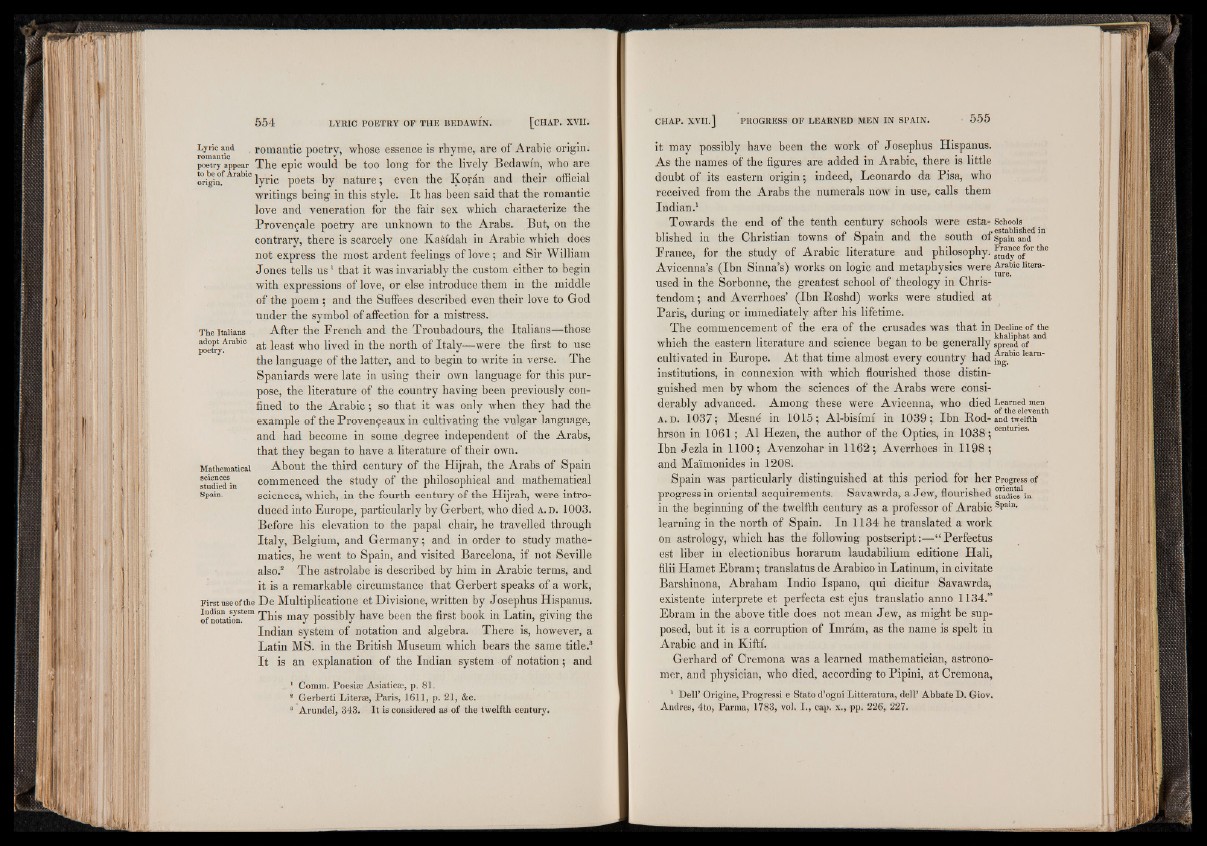
Lyric and romantic poetry, whose essence is rhyme, are of Arabic origin, romsotic _ poetry appear The epic would be too long for the lively Bedawin, who are
originfArabic lyric poets by nature ; even the Koran and their official
writings being in this style. It has been said that the romantic
love and veneration for the fair sex which characterize the
Provençale poetry are unknown to the Arabs. But, on the
contrary, there is scarcely one Kasidah in Arabic which does
not express the most ardent feelings of love ; and Sir William
Jones tells us1 that it was invariably the custom either to begin
with expressions of love, or else introduce them in the middle
of the poem ; and the Suffees described even their love to God
under the symbol of affection for a mistress.
The Italians After the French and the Troubadours, the Italians—those
poetryArablC at least who lived in the north of Italy—were the first to use
the language of the latter, and to begin to write in verse. The
Spaniards were late in using their own language for this purpose,
the literature of the country having been previously confined
to the Arabic ; so that it was only when they had the
example of the Provençeaux in cultivating the vulgar language,
and had become in some degree independent of the Arabs,
that they began to have a literature of their own.
Mathematical About the third century of the Hijrah, the Arabs of Spain
studiedYn commenced the study of the philosophical and mathematical
Spain. sciences, which, in the fourth century of the Hijrah, were introduced
into Europe, particularly by Gerbert, who died a . d . 1003.
Before his elevation to the papal chair, he travelled through
Italy, Belgium, and Germany ; and in order to study mathematics,
he went to Spain, and visited Barcelona, if not Seville
also.2 The astrolabe is described by him in Arabic terms, and
it is a remarkable circumstance that Gerbert speaks of a work,
First use of the De Multiplicatione et Divisione, written by Josephus Hispanus.
of notation!*111 This may possibly have been the first book in Latin, giving the
Indian system of notation and algebra. There is, however, a
Latin MS. in the British Museum which bears the same title.3
It is an explanation of the Indian system of notation ; and
1 Comm. Poesi® Asiatic®, p. 81.
* Gerberti Liter®, Paris, 1611, p. 21, &c.
8 Arundel, 343. I t is considered as of the twelfth century.
it may possibly have been the work of Josephus Hispanus.
As the names of the figures are added in Arabic, there is little
doubt of its eastern origin; indeed, Leonardo da Pisa, who
received from the Arabs the numerals now in use, calls them
Indian.1
Towards the end of the tenth century schools were esta- Schools
blished in the Christian towns of Spain and the south ofspamand
France, for the study of Arabic literature and philosophy. ft[adnyoeoffor the
Avicenna’s (Ibn Sinna’s) works on logic and metaphysics were ^ bic litera-
used in the Sorbonne, the greatest school of theology in Christendom
; and Averrhoes’ (Ibn Roshd) works were studied at
Paris, during or immediately after his lifetime.
The commencement of the era of the crusades was that in Decline of the
which the eastern literature and science began to be generally spreadrf
cultivated in Europe. At that time almost every country had ^ bic learn"
institutions, in connexion with which flourished those distinguished
men by whom the sciences of the Arabs were considerably
advanced. Among these were Avicenna, who died Learned men
, of the eleventh
a . d . 1037; Mesné in 1015; Al-bisimi in 1039; Ibn Rod-and twelfth
hrson in 1061; A1 Hezen, the author of the Optics, in 1038;centunes-
Ibn Jezla in 1100; Avenzohar in 1162; Averrhoes in 1198;
and Ma'imonides in 1208.
Spain was particularly distinguished at this period for her Progress of
progress in oriental acquirements. Savawrda, a Jew, flourished sSes'in
in the beginning of the twelfth century as a professor of Arabic Spam-
learning in the north of Spain. In 1134 he translated a work
on astrology, which has the following postscript:— “ Perfectas
est liber in electionibus horarum laudabilium editione Hali,
filii Hamet Ebram; translatas de Arábico in Latinum, in civitate
Barshinona, Abraham Indio Ispano, qui dicitur Savawrda,
existente interprete et perfecta est ejus translatio anno 1134.”
Ebram in the above title does not mean Jew, as might be supposed,
but it is a corruption of Imrám, as the name is spelt in
Arabic and in Kifti.
Gerhard of Cremona was a learned mathematician, astronomer,
and physician, who died, according to Pipini, at Cremona,
1 Dell’ Origine, Progressi e Stato d’ogni L itteratura, dell’ Abbate D. Giov.
Andres, 4to, Parma, 1783, vol. I ., cap. x., pp. 226, 227.